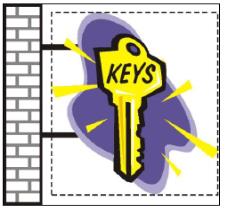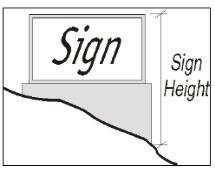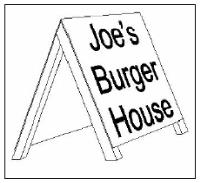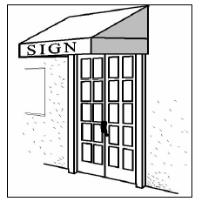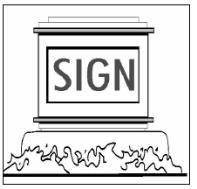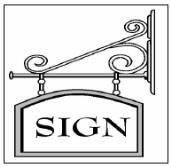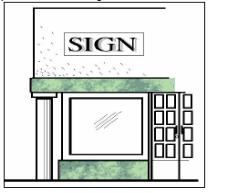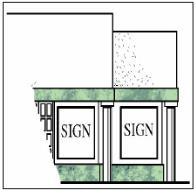Chapter 18.38
Signs
Sections:
18.38.030 Sign Permit Requirements
18.38.040 Exemptions from Sign Permit Requirements
18.38.060 General Requirements for All Signs
18.38.070 Zoning District Sign Standards
18.38.080 Standards for Specific Sign Types
18.38.100 Violations, Enforcement, Abatement
18.38.120 Partial Invalidation
18.38.010 - Purpose
The regulations established by this Chapter are intended to appropriately limit the placement, type, size, and number of signs allowed within the City, and to require the proper maintenance of signs. The purposes of these limitations and requirements are to:
A. Avoid traffic safety hazards to motorists, bicyclists, and pedestrians, caused by visual distractions and obstructions;
B. Promote the aesthetic and environmental values of the community by providing for signs that do not impair the attractiveness of the City as a place to live, work, and shop;
C. Provide for signs as an effective channel of communication, while ensuring that signs are aesthetically proportioned in relation to adjacent structures and the structures to which they are attached;
D. Safeguard and protect the public health, safety, and general welfare; and
E. Advance community design standards and safety standards as set forth in the Community Design and Safety Elements of the General Plan.
(Ord. 930, § 2, passed 06-12-2017)
18.38.020 - Applicability
A. Signs regulated. The requirements of this Chapter shall apply to all signs in all zoning districts.
B. Applicability to sign content. The provisions of this Chapter do not regulate the message content of signs (sign copy), regardless of whether the message content is commercial or noncommercial.
C. Definitions. Definitions of the specialized terms and phrases used in this Chapter may be found in Article 10 (Definitions) under “Sign.”
(Ord. 930, § 2, passed 06-12-2017)
18.38.030 - Sign Permit Requirements
A. Sign Permit required.
1. Approval required. No sign shall be constructed, installed, or modified, unless a Sign Permit is first obtained in compliance with this Section, or the sign is allowed without a Sign Permit by § 18.38.040 (Exemptions from Sign Permit Requirements).
2. Compliance with standards required. No Sign Permit shall be approved for an existing or proposed sign unless the sign is in compliance with all applicable requirements of this Chapter.
3. Building Permit required. A Building Permit may also be required for sign construction/installation.
4. Temporary signs. Temporary signs shall comply with §§ 18.38.040(C) (Temporary signs) and 18.38.080 (Standards for Specific Sign Types).
B. Review authority.
1. Director. The Director shall review all Sign Permit applications and approve only those that comply with the findings required in Subsection (D) of this Section (Findings for approval). The Director may also refer a Sign Permit application to the Commission for review and decision, either for the individual Sign Permit, or as part of a development project that is otherwise subject to design review. Commission review of a Sign Permit referred by the Director shall require no additional fee.
2. Conditions of approval. The review authority may require conditions of approval that are deemed reasonable and necessary to achieve the purpose, intent, and objectives of this Chapter to the extent such conditions relate to the shape, location, height, size and materials of the sign; and/or the shape, design, placement, color, style, and quantity of text, illumination, reflected light and logos of a sign.
3. Approval criteria. The approval or nonapproval of an application for a Sign Permit shall be guided by the criteria set forth in this Chapter. If the review authority finds that a proposed sign substantially complies with the standards of this Chapter, the review authority shall approve the sign.
4. Appeal. A decision of the Director or Commission in compliance with this Chapter may be appealed in compliance with Chapter 18.92 (Appeals).
C. Sign Permit procedures.
1. Application requirements. An application for a Sign Permit shall be prepared, filed, and processed in compliance with Chapter 18.70 (Permit Application Filing and Processing).
2. Application contents. Each application shall include all fees required by the City’s Fee Schedule, and all of the following:
a. Plans for the sign, drawn to scale, showing the proposed location of the sign in relation to other signs on the site and adjacent properties, structures, and uses;
b. A complete color scheme for the sign, and design drawing of the sign;
c. Sufficient other details of the proposed sign to show that it complies with the provisions of this Chapter;
d. Written permission from the property owner for the placement of the proposed signs on the site;
e. Computation of the total sign area, the area of each individual sign, the height of each sign, and the total number of existing and proposed signs on the site;
f. An accurate indication on the site plan of the proposed location of each present and future sign of any type, whether requiring a permit or not;
g. If a Sign Permit application is filed for a site where signs exist, the application shall include a schedule for bringing into conformance, within 5 years of the application date, all signs not conforming with the requirements of this Chapter as of the date of application; and
h. Other information as required by the Department.
D. Findings for approval. The approval of a Sign Permit shall require that the review authority first make all the following findings, as applicable:
1. The proposed signs do not exceed the standards of §§ 18.38.070 (Zoning District Sign Standards) and 18.38.080 (Standards for Specific Sign Types), and are of the minimum size and height necessary to enable pedestrians and motorists to readily identify the facility or site from a sufficient distance to safely and conveniently access the facility or site;
2. That the placement of the sign on the site is appropriate for the height and area of a freestanding or projecting sign;
3. That a flush or projecting sign relates to the architectural design of the structure. Signs that cover windows, or that spill over natural boundaries, and/or cover architectural features shall be discouraged;
4. The proposed signs do not unreasonably block the sight lines of existing signs on adjacent properties;
5. The placement and size of the sign will not impair pedestrian or vehicular safety;
6. The design, height, location, and size of the signs are visually complementary and compatible with the scale and architectural style of the primary structures on the site, any prominent natural features on the site, and structures and prominent natural features on adjacent properties on the same street; and
7. The proposed signs are in substantial conformance with the design criteria in § 18.38.060(E) (Design criteria for signs) and the Citywide Design Guidelines for signs.
E. Expiration and extension of Sign Permit approval.
1. Approval of a Sign Permit shall expire 12 months from the date of approval unless the sign has been installed, or a different expiration date is stipulated at the time of approval. Before the expiration of a Sign Permit, the applicant may apply to the Department for an extension of an additional 12 months from the original date of expiration.
2. The expiration date of the Sign Permit shall be automatically extended to concur with the expiration date of the companion Building Permit or other applicable permits for the project.
(Ord. 930, § 2, passed 06-12-2017)
18.38.040 - Exemptions from Sign Permit Requirements
The following signs are allowed without Sign Permit approval; provided, that they comply with § 18.38.060 (General Requirements for All Signs), and any required Building Permit is obtained:
A. Nonstructural modifications and maintenance.
1. Modifications to sign copy on conforming signs, or changes to the face or copy of conforming changeable copy signs;
2. The normal maintenance of conforming signs, except as identified in § 18.38.060(H) (Maintenance of signs).
B. Identification signs. Street identification and house identification signs required to assist emergency responders in finding specific properties and not exceeding 2 square feet.
C. Temporary signs. The following temporary signs are allowed without a Sign Permit:
1. Signs posted on private property for the sale, lease or rental of the property.
a. Commercial, industrial, and other nonresidential zoning districts. Signs posted on private property for the sale, lease or rental of the property within commercial, industrial, and other nonresidential zoning districts shall be no more than 16 square feet, with a maximum height for freestanding signs of 6 feet.
b. Residential zoning districts. Signs posted on private property for the sale, lease or rental of the property in residential zoning districts shall not be illuminated, shall not exceed 1 sign per property, and shall be no more than 4 square feet in area, including riders.
2. Off-site directional signs not more than 4 square feet in area, including riders, may be located on private property for the sale, lease or rental of a property; provided, that they do not obstruct or impede pedestrian or vehicular traffic, and are not secured to prevent removal. No such sign shall be permitted within a public right-of-way.
3. Signs on property undergoing construction or remodeling may be allowed in all zoning districts in compliance with the following standards:
a. The number, type, placement, and size of signs shall comply with the sign requirements of § 18.38.070 (Zoning District Sign Standards) for the applicable zoning district.
b. The signs shall be removed prior to final building inspection or the issuance of a certificate of occupancy.
4. Signs are allowed 90 days prior to an election and 5 days after an election so long as the sign is in compliance with the following requirements:
a. In commercial and industrial zoning districts, each temporary sign and the total temporary signage on a parcel shall not exceed 32 square feet in area.
b. In residential districts, no temporary sign shall exceed 4 square feet in area.
c. No temporary sign shall be located in a public right-of-way.
D. Governmental signs. Signs installed by the City, County, or a Federal or State governmental agency, because of their responsibilities for the protection and promotion of public health, safety, and general welfare, including the following signs:
1. Emergency and warning signs necessary for public safety or civil defense;
2. Traffic signs erected and maintained by an authorized public agency;
3. Legal notices, licenses, permits, and other signs required to be displayed by law;
4. Signs showing the location of public facilities (e.g., public telephones, restrooms, and underground utilities); and
5. Any sign, posting, notice, or similar sign placed by or required by a governmental agency in carrying out its responsibility to promote and protect public health, safety, and general welfare.
E. Miscellaneous signs.
1. Address numbers not exceeding 12 inches in height required to assist emergency responders in finding specific properties.
2. Official flags. Flags of national, State, or local governments, or nationally recognized religious, fraternal, or public service agencies; provided, the length of the flag shall not exceed 1/4 the height of the flag pole, and the flag is not used for commercial advertising.
3. Symbols, pictures, patterns, and illumination approved as architectural ornamentation or decoration by the review authority.
4. Signs erected and maintained by a historical agency or nonprofit and located on a historical building, including names and dates of buildings and date of construction so long as none of these exceed 4 square feet.
5. Service station price signs required by State law.
6. Signs or displays located entirely inside of a building.
7. Small, temporary signs, otherwise in conformance with size, number, and duration requirements of this chapter that address noncommercial issues.
8. Banners and flags of 12 square feet or less, without commercial messages that do not interfere with pedestrian access or vehicular traffic within the public right-of-way (sidewalk and or street).
9. Signs advertising nonprofit events that are less than 100 square feet and located on private property with the permission of the property owner. Nonprofit event signs shall not be displayed for a period of more than 30 days and shall be removed immediately after the event occurs. The advertised nonprofit events must be located within the City of Fort Bragg.
(Ord. 930, § 2, passed 06-12-2017)
18.38.050 - Prohibited Signs
All signs not expressly allowed by this Chapter shall be prohibited. Examples of prohibited signs include the following:
A. Abandoned signs;
B. Animated signs, including electronic message display signs, and variable intensity, blinking, or flashing signs, or signs that emit a varying intensity of light or color;
C. Balloons and other inflatable devices;
D. Billboards;
E. Flags which include commercial messages logos or images, are distracting to drivers, and/or are larger than 30 square feet, except as specifically allowed by § 18.38.040(E)(2) (Official flags);
F. Moving signs, except signs that are stationary but contain moving parts;
G. Obscene signs;
H. Off-premises signs, except as allowed by § 18.38.040(C)(2) (Off-site directional signs);
I. Pennants and streamers, except in conjunction with an athletic event, carnival, circus, or fair, or as allowed in § 18.38.040(C) (Temporary signs);
J. Pole signs and other freestanding signs over 14 feet in height;
K. Roof signs;
L. Because of the City’s compelling interest in ensuring traffic safety, signs that simulate in color, size, or design any traffic control sign or signal, or that make use of words, symbols, or characters in a manner that interferes with, misleads, or confuses pedestrian or vehicular traffic; and signs that due to color or motion act as a distraction and safety hazard to drivers;
M. Signs in the form or shape of a directional arrow, or otherwise displaying a directional arrow, except as may be approved by the review authority for safety, convenience and control of vehicular and pedestrian traffic within the premises of the subject use;
N. Signs attached to or suspended from a boat, float, vehicle, or other movable objects parked within a public right-of-way, or in a location on private property that is visible from a public right-of-way, except a sign painted directly upon, magnetically affixed to, or permanently affixed to the body or other integral part of the vehicle;
O. Signs burned, cut, or otherwise marked on or otherwise affixed to a hillside or tree;
P. Signs with reflective material;
Q. Signs in residential zoning districts, except as specifically allowed in this Chapter;
R. Temporary and portable signs, except as specifically allowed by § 18.38.040(C) (Temporary signs);
S. Signs in the public right-of-way except for the following:
1. Public signs erected by or on behalf of a governmental agency to convey public information, identify public property, post legal notices, or direct or regulate pedestrian or vehicular traffic;
2. Bus stop signs installed by a public transit company;
3. Informational signs of a public utility regarding its lines, pipes, poles, or other facilities. Emergency warning signs erected by a governmental agency, a public utility company, or a contractor doing authorized work within the public right-of-way; or
4. Temporary signs held by individuals that display noncommercial messages of less than 10 square feet; and
T. Any sign installed or placed within the public right-of-way other than in compliance with this Section shall be forfeited to the public and be subject to confiscation.
In addition to other remedies identified in Chapter 18.98 (Enforcement and Penalties), the City shall have the right to recover from the owner, or person placing the sign, the full costs for sign removal and disposal.
(Ord. 930, § 2, passed 06-12-2017)
18.38.060 - General Requirements for All Signs
The following rules shall govern the computation of sign area:
A. Sign area measurement. Sign area measurement to determine compliance with the sign area limitations of this Chapter shall occur as follows:
1. Surface area. The surface area of a sign shall be calculated by enclosing the extreme limits of all framing, emblem, logo, representation, writing, or other display within a single continuous perimeter composed of squares or rectangles with no more than 8 perimeter lines. See Figure 3-10.
Figure 3-10 - Sign Area Measurement
|
2. Sign structure. Supporting bracing or framework that is clearly incidental to the display itself shall not be computed as sign area. 3. Multi-faced signs. The sign area for a sign with more than 1 face shall be computed by adding together the area of all sign faces. 4. Three-dimensional objects. The area of a sign consisting of 1 or more 3-dimensional objects (e.g., balls, cubes, clusters of objects, sculpture, or statue-like trademarks), shall be measured as their maximum projection upon a vertical plane. See Figure 3-11. 5. Time and/or temperature device. The area of any time and/or temperature device incorporated into a sign shall not be included in the calculation of total sign area. |
|
|
Figure 3-11 - Sign Area Measurement for 3D Signs |
|
B. Sign height measurement. The height of a sign shall be computed as the vertical distance from the lowest point of the base of the sign at normal grade, to the top of the highest attached component of the sign. See Figure 3-12. Normal grade shall be construed to be the lower of either the: 1. Existing grade before construction; or 2. Newly established grade after construction, exclusive of any berming, filling, mounding, or excavating solely for the purpose of locating the sign. |
|
|
Figure 3-12 - Sign Height Measurement |
C. Sign height limitations.
1. Maximum height for freestanding signs. A freestanding sign shall not exceed a height of 6 feet above normal grade in the residential and PF zoning districts. Freestanding signs shall be limited to 14 feet above normal grade in all other districts.
2. Maximum height for signs on structures. The top of a sign mounted on a structure shall not extend higher than the lesser of:
a. The window sills of the second floor;
b. The top of the wall to which the sign is attached, in the case of a 1-story structure; or
c. Twenty feet above normal grade.
D. Sign location requirements. Each sign shall be located in compliance with the following requirements, and all other applicable provisions of this Chapter:
1. Each sign shall be located on the same site as the subject of the sign, except as otherwise allowed by this Chapter.
2. No sign shall project over public property, or the public right-of-way, except where the City has granted an Encroachment Permit in addition to a Sign Permit.
3. No sign shall be placed so as to interfere with the operation of a door, window, or fire escape.
E. Design criteria for signs. The following design criteria shall be used in reviewing the design of individual signs. Substantial conformance with each of the following design criteria shall be required before a Sign Permit or Building Permit can be approved.
1. Color. Colors on signs and structural members should be harmonious with one another and relate to the dominant colors of the other structures on the site. Contrasting colors may be utilized if the overall effect of the sign is still compatible with the structure colors and prevailing colors in the surrounding neighborhood (where a theme can be identified).
2. Design and construction.
a. Proposed permanent signs should be designed by professionals (e.g., architects, building designers, landscape architects, interior designers, or those whose principal business is the design, manufacture, or sale of signs), or others who are capable of producing professional results.
b. All permanent signs should be constructed by persons whose principal business is building construction or a related trade including sign manufacturing and installation businesses, or others capable of producing professional results. The intent is to ensure public safety, achieve signs of careful construction, neat and readable copy, and durability so as to reduce maintenance costs and to prevent dilapidation.
3. Materials and structure.
a. Sign materials (including framing and supports) shall be representative of the type and scale of materials used on the primary on-site structure and on other on-site signs.
b. Materials for permanent signs shall be durable and capable of withstanding weathering over the life of the sign with reasonable maintenance.
c. The size of the structural members (e.g., columns, crossbeams, and braces) should be proportional to the sign panel they are supporting. In general, fewer larger supporting members are preferable to many smaller supports.
d. The use of individual letters incorporated into the building design is encouraged, rather than signs with background and framing other than the structure’s wall(s).
4. Street address. The review authority may require that a sign include the street address of the site, where it determines that public safety and emergency vehicle response would be more effectively served than if the street address were displayed solely on 1 or more structures on the site.
F. Copy design guidelines. The City does not regulate the message content (copy) of signs; however, the following are principles of copy design and layout that can enhance the readability and attractiveness of signs. Copy design and layout consistent with these principles is encouraged, but not required.
1. Sign copy should relate only to the name and/or nature of the business or commercial center.
2. Permanent signs that advertise continuous sales, special prices, or include phone numbers, etc., should be avoided.
3. Information should be conveyed briefly or by logo, symbol, or other graphic manner. The intent should be to increase the readability of the sign and thereby enhance the identity of the business.
4. The area of letters or symbols should not exceed 40% of the background area in commercial districts or 60% in residential districts.
5. Freestanding signs should contain the street address of the parcel or the range of addresses for a multi-tenant center.
G. Sign lighting. Sign lighting shall be designed to minimize light and glare on surrounding rights-of-way and properties.
1. External light sources shall be directed and shielded so that they do not produce glare on any object other than the sign, and/or off the site of the sign.
2. The light illuminating a sign shall not be of an intensity or brightness that will interfere with the reasonable enjoyment of residential properties.
3. Sign illumination shall not blink, flash, flutter, or change light intensity, brightness, or color.
4. Colored lights shall not be used at a location or in a manner so as to be confused or construed as traffic control devices.
5. Neither the direct nor reflected light from primary light sources shall create hazards for pedestrians or operators of motor vehicles.
6. Reflective-type bulbs and incandescent lamps that exceed 15 watts shall not be used so as to expose the face of the bulb or lamp to a public right-of-way or adjacent property.
7. Light sources shall utilize hard-wired fluorescent or compact fluorescent lamps, or other lighting technology that is of equal or greater energy efficiency.
8. Permanently installed illuminated panels, visible tubing, and strings of lights outlining all or a portion of a structure, other than lighting that is primarily for indirectly illuminating architectural features, signs, or landscaping, shall be deemed “signs” subject to this Chapter and shall be counted as part of the allowed sign area. Each line of tubing or lights shall be deemed to have a minimum width of at least 6 inches for the purpose of area calculation.
H. Maintenance of signs.
1. Each sign and supporting hardware, including temporary signs, shall be maintained in good repair and functioning properly at all times.
2. Any repair to a sign shall be of equal or better in quality of materials and design as the original sign.
3. A sign that is not properly maintained and is dilapidated shall be deemed a public nuisance, and may be abated in compliance with the Municipal Code.
4. When an existing sign is removed or replaced, all brackets, poles, and other supports that are no longer required shall be removed.
5. Unpainted areas shall be painted to match the adjacent portion of the structure or the sign support structure.
(Ord. 930, § 2, passed 06-12-2017)
18.38.070 - Zoning District Sign Standards
Each sign shall comply with the sign type, area, height, and other restrictions provided by this Section, except as otherwise expressly provided in § 18.38.080 (Standards for Specific Sign Types).
A. Residential and PF zoning districts. Each sign in a residential or PF zoning district shall comply with the following requirements:
|
Allowed Sign Types |
Maximum Sign Height |
Maximum Number of Signs Allowed per Parcel |
Maximum Sign Area Allowed per Parcel |
|---|---|---|---|
|
|
|||
|
Wall or freestanding |
Wall signs: below edge of roof; Freestanding: 6 ft |
1 of either allowed sign type per street frontage |
12 sf maximum each; 24 sf total for all signs |
B. Commercial and industrial zoning districts. Each sign in the commercial and industrial zoning districts established by § 18.14.020 (Zoning Map and Zoning Districts) shall comply with the requirements in Table 3-12, in addition to the provisions of § 18.38.080 (Standards for Specific Sign Types), as applicable.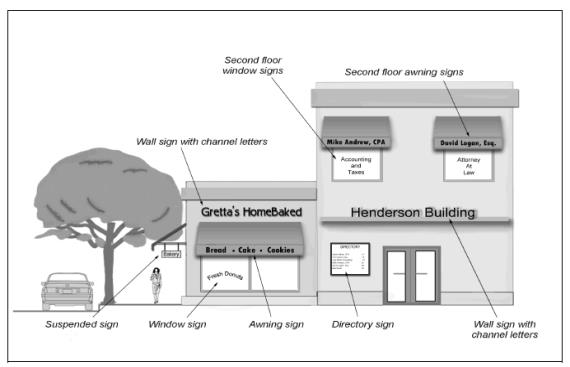
Figure 3-13 - Examples of sign types
|
Allowed Sign Types |
Maximum Sign Height |
Maximum Number of Signs Allowed per Parcel |
Maximum Sign Area |
|---|---|---|---|
|
Ground-mounted and Ground-floor Signs |
|||
|
Awning (§ 18.38.080(B)) |
Below roof (1) |
Single tenant site or structure: 3 of any combination of allowed sign types per primary structure frontage. 1 of any allowed sign type per secondary frontage. Site or structure with 2 or more tenants: 2 of any allowed sign per business frontage. |
Maximum sign area per parcel. The total sign area on a parcel shall comply with the following requirements. 1. 2 sf for each 3 linear ft of primary building frontage. 2. 0.5 additional sf for each linear foot of secondary building frontage. 3. Each tenant is allowed a total sign area of at least 25 sf regardless of frontage length. 4. The total sign area per tenant shall not exceed 100 sf. Maximum sign area per building frontage. The total area of all signs on a single structure frontage shall not exceed the total linear feet of that frontage. Site with 4 or more tenants: is allowed an additional freestanding identification sign of 0.25 sf for each linear ft of total primary structure frontage, up to 100 sf maximum. |
|
Freestanding (§ 18.38.080(C)) |
14 ft |
||
|
Projecting, Wall (§ § 18.38.080(E), 18.38.080(G)) |
Below roof (1) |
||
|
Suspended (§ 18.38.080(G)) |
Below eave/canopy; at least 8 ft above a walking surface |
||
|
Temporary/ Portable |
See §§ 18.38.080(A) and (F) |
||
|
Window |
See § 18.38.080(H) |
||
|
Second Floor Signs |
|||
|
Awning, Projecting, Wall |
Below roof (1) |
1 per tenant space. |
12 sf for each tenant. 1 directory sign not to exceed 12 sf is also allowed to identify upper floor occupants. |
|
Window |
See § 18.38.080(H) |
||
|
Indoor Signs, and Outdoor Signs Not Visible from a Street |
|||
|
Awning, Freestanding, Projecting, Suspended, Wall, Window |
Below roof (1) |
See § 18.38.080, as applicable. |
|
Notes:
(1) At least 1 foot below the top of a parapet, the sill of a second floor window, and/or the lowest point of any cornice or roof overhang.
(Ord. 930, § 2, passed 06-12-2017)
18.38.080 - Standards for Specific Sign Types
Proposed signs shall comply with the following standards applicable to the specific sign type. Each sign type listed in this Section shall be included in the calculation of the total sign area allowed on a parcel by § 18.38.070 (Zoning District Sign Standards), unless this Section explicitly provides otherwise. Each sign shall also comply with the sign area, height, and other requirements of § 18.38.060, and all other applicable provisions of this Chapter. Any noncommercial message may be substituted for the copy on any commercial sign allowed by this Chapter.
|
A. A-board and other portable sidewalk signs. Each business may display 1 A-board or other portable sign in compliance with the following standards: 1. Limitation on location. An A-board or other portable sign shall be allowed only on private property. 2. Sign size. Each sign shall not exceed a width of 2 feet 6 inches. Sign height shall be limited to 4 feet. Sign height shall be measured perpendicular from the sidewalk surface to the highest point of the A-board sign. |
|
|
Figure 3-15 - A-Board Sign |
3. Sign placement. A portable sidewalk sign shall be placed only on private property within the boundaries of the applicable business’s street frontage, and shall be positioned so that it will not:
a. Obstruct required ADA sidewalk clearance;
b. Impede any line of sight for motorists at vehicular public right-of-way intersections, as recommended by the Director, Public Works; or
c. Interfere with people exiting and entering parked cars.
4. Design and construction standards. The review authority shall approve an A-frame sign only if it first determines that the design and appearance of the sign, including any graphics and/or text, will reflect attractive, professional design, and that the sign will be durable and stable when in place.
5. Stabilization. The sign shall be stabilized to withstand wind gusts or shall be removed during windy conditions.
6. Daily removal. The sign shall be removed at the close of business each day.
7. Maintenance. The sign shall be continuously maintained in good condition with no peeling paint or other deterioration.
|
B. Awning signs. The following standards apply to awning signs in all zoning districts where allowed by § 18.38.070 (Zoning District Sign Standards): 1. Signs on awnings are limited to ground level or second story occupancies only. 2. Awnings shall not be internally illuminated. Direct exterior lighting may be allowed. Translucent awning materials are prohibited. C. Freestanding signs. The following standards apply to freestanding signs in all zoning districts where allowed by § 18.38.070 (Zoning District Sign Standards): |
|
|
Figure 3-16 - Awning Sign |
|
1. Multiple signs shall be separated by a minimum of 75 feet to ensure adequate visibility for all signs. The review authority may waive this requirement where the locations of existing signs on adjacent properties would make the 75-foot separation impractical. 2. A sign shall not project over public property, vehicular easements, or rights-of-way, and shall not obstruct a traffic safety sight area, as determined by the review authority. 3. To assist emergency response personnel in locating the site, freestanding signs should contain an illuminated street address plate. Numbers should be a minimum of 6 inches in height. Street address numbers not exceeding 6 inches in height shall not be included in calculations of allowed sign area. |
|
|
Figure 3-17 - Freestanding Sign |
D. Murals. A mural placed on the wall of a structure may be allowed in any commercial or industrial zoning district subject to Administrative Design Review, and as follows:
1. A mural without text visible from a public right-of-way may be approved in addition to (not counted as part of) the sign area allowed by § 18.38.070 (Zoning District Sign Standards); a mural with text shall comply with the sign area limitations applicable to the site.
2. Murals that illustrate the local setting, natural environment, and history as sources of inspiration are encouraged.
|
3. The approval of a mural shall require that the review authority first find that the size, colors, and placement of the mural are visually compatible with the structure architecture, and that the mural will serve to enhance the aesthetics of the City. E. Projecting signs. The following standards apply to projecting signs in all zoning districts where allowed by § 18.38.070 (Zoning District Sign Standards): 1. The maximum projection of a sign from a structure wall shall not exceed 8 feet or more than 2/3 of the width of the public sidewalk below. Any projection over a public right-of way shall require an Encroachment Permit. |
|
|
Figure 3-18 - Projecting Sign |
2. The top of a projecting sign shall not exceed the lesser of 14 feet, eave height, parapet height, or sill height of a second floor window. No portion of the sign shall project above the eave line of a sloped roof or the top of the parapet on a flat roof.
3. A projecting sign shall maintain a minimum clearance of 8 feet from the bottom of the sign to the finished grade below.
|
4. Icon signs using shapes or symbols uniquely suited to the business, creative shapes, and 3-dimensional signs are encouraged. See Figure 3-19. 5. Each sign shall be graphically designed for pedestrians, with a maximum area of 9 square feet on each sign face, regardless of the length of the building frontage. Within the CBD zoning district, no sign face shall exceed a maximum area of 12.5 square feet. 6. Sign supports shall be well designed and compatible with the design of the sign. |
|
|
Figure 3-19 - Use of Icons/Symbols |
F. Temporary signs and banners. Temporary signs other than A-boards are allowed subject to the following requirements. A-board signs are instead subject to the requirements of Subsection (A) of this Section.
1. Temporary signs on private property, except as identified in § 18.38.040(C), shall comply with the following requirements:
a. Time limits. The use of a temporary sign may be allowed only for a licensed business for a period not to exceed 30 days per year. A Temporary Sign Permit may be issued for up to 30 days. A business is only allowed 3 Temporary Sign Permits per year. This is in addition to the 30 days allowed for a business grand opening temporary sign. Signs advertising a particular event shall be removed within 10 days after the event.
b. The application for a Temporary Sign Permit shall include the dates proposed by the applicant for scheduled banner use.
c. Temporary signs may be authorized by the Director, upon submittal of a sign application, plan for removal, and the fees required by the City’s Fee Schedule.
d. Maximum sign area. In a residential zoning district, the combined area of temporary signs shall not exceed 3 square feet. In a commercial or industrial zoning district, the combined area of temporary signs shall not exceed that permitted for permanent signage in the district in which the sign will be placed.
e. Maximum number of signs. No more than 1 temporary sign shall be erected on a premises at a time.
|
f. Sign placement. Temporary signs shall be subject to the same placement and height restrictions as permanent signs for the applicable zoning district, except for inflated and tethered signs. g. Inflatable or tethered signs. Inflatable or tethered signs are permitted for special events and may be installed for a period not to exceed 5 consecutive days, no more than 2 times per year. These signs may exceed the maximum sign area and sign height standards for the applicable zoning district. |
|
|
Figure 3-20 - Wall Sign |
G. Wall signs. The following standards apply to wall signs in all zoning districts where allowed by § 18.38.070 (Zoning District Sign Standards).
1. A wall sign may be located on any primary or secondary structure frontage.
2. The area of the largest wall sign shall not exceed 7% of the area of the building facade on which the sign is mounted or painted, including the area of windows, doors, and recesses.
3. A wall sign shall not project more than 12 inches from the surface to which it is attached.
|
H. Window signs. The following standards apply to temporary and permanent window signs where allowed by § 18.38.070 (Zoning District Sign Standards). 1. Maximum sign area. Permanent and temporary window signs shall not occupy more than 20% of the total window area. 2. Sign location. Signs shall be allowed only on windows located on the ground level and second story of a structure frontage. |
|
|
Figure 3-21 - Window Sign |
3. Sign materials. Neon and LCD signs with blinking lights, changing letters, or lighted moving graphics are discouraged.
(Ord. 930, § 2, passed 06-12-2017)
18.38.090 - Nonconforming Signs
A nonconforming sign is any permanent or temporary sign that was legally established and maintained in compliance with the provisions of all applicable laws in effect at the time of original installation but that does not now comply with the provisions of this Development Code.
A. General requirements. A nonconforming sign shall not be:
1. Changed to another nonconforming sign;
2. Structurally altered to extend its useful life;
3. Enlarged;
4. Re-established after a business is discontinued for 30 days; or
5. Re-established after damage or destruction to 50% or more of the value of the sign, or its components, as determined by the Building Official.
Any interruption in the use of a nonconforming sign that continues for 60 days or more shall be deemed to be an abandonment of the sign. Subsequent use shall comply with the regulations of this Chapter. Nonoccupation or nonoperation of the building or business advertised shall be deemed an interruption of the use of the sign.
B. Exceptions. An administrative exception to the requirements of Subsection (A) of this Section may be granted by the Commission; provided, that the Commission shall make the following findings:
1. The new proposed sign is significantly more conforming in height and/or area than the existing sign; and
2. By approving the new sign, the exception will eliminate the existing nonconforming sign.
C. Maintenance and changes. Sign copy and face changes, nonstructural modifications, and nonstructural maintenance (e.g., painting, rust removal) are allowed without a Sign Permit up to a maximum of 25% of the existing total area of the sign. Face changes not including copy, and any nonstructural modifications exceeding 25% of the existing total area of the sign, and any structural changes shall comply with all applicable standards of this Chapter.
(Ord. 930, § 2, passed 06-12-2017)
18.38.100 - Violations, Enforcement, Abatement
A. Signs on vacated buildings. Signs on premises that have been vacated for 60 days or more and signs on multi-tenant buildings advertising a business that has been vacated for 60 days or more shall be immediately removed by the owner after the expiration of that period. The Director may issue a Municipal Code violation and/or a notice to remove signs and sign standards after the expiration of the 60-day period in conformance with § 18.98.080.
B. Violation, abatement, penalties. Any sign within the City that fails to comply with the requirements of this Chapter, other applicable State statute or City ordinance, or for which a permit has not been obtained in compliance with this Chapter, shall be subject to abatement through civil legal proceedings or as an infraction punishable by a fine as set forth in Chapter 18.98 (Enforcement and Penalties).
(Ord. 930, § 2, passed 06-12-2017)
18.38.110 - Judicial Review
Any permit issued or denied in compliance with this Chapter shall be subject to expedited judicial review to the extent provided by the time limits identified in Code of Civil Procedure Section 1094.6 et seq.
(Ord. 930, § 2, passed 06-12-2017)
18.38.120 - Partial Invalidation
This Chapter and its various parts are hereby declared to be severable. Should any section of this Chapter be declared by a court to be unconstitutional or invalid, that decision shall not affect the validity of the Chapter as a whole, or any portion of the Chapter, other than the section declared to be unconstitutional or invalid.
(Ord. 930, § 2, passed 06-12-2017)



